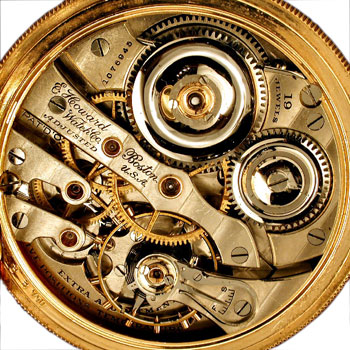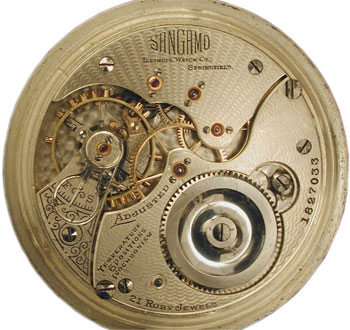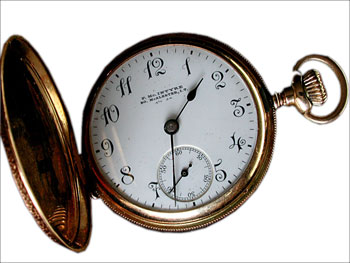ollectors Weekly: What attracts you to a pocket watch?
McIntyre: The quality of the movement, how well it’s made, and the attractiveness of the mechanism itself. Generally I look for a nice dial and a nice case, but on American watches, you can often find a case for the watch, so it’s not as critical to have the best grade case. Some of my friends only will collect something if they have really strong evidence that the case and the dial and the movement have always been together since the watch was first made, so that restricts their collecting quite a bit. But they’ll pay a lot more money for a watch if you can prove that to them.
That’s another aspect of collecting. It’s called originality. I often collect authentic examples but not necessarily original examples, where some other people only collect original examples. People who collect all-original watches spend hours painstakingly looking at the cases on the inside to see if there’re any extra scratches where somebody might have taken something apart at one point in time and just examine them microscopically to determine whether or not they’re original.
Sometimes you know it’s original just because of the provenance. If you bought it from the great-great-granddaughter of a U.S. senator that bought it originally in 1863, I’m reasonably sure that since that’s been sitting in the family vault for the last 85 years, it’s original.
But for me, the case isn’t necessarily important because you can often find an authentic case. Watches get damaged, and the movement may or may not be worth repairing, and if it’s a lesser grade of movement, it might not get repaired, in which case somebody is offering the case for sale independently of the movement. But of course, there are a lot more movements than there are cases because in times like today, when gold is at a very high price, the premium for having that gold made into a watch case is not all that high over the value of the gold itself.
The gold in a typical American men’s pocket watch today starts off for a relatively lightweight case at around a thousand dollars and can go up to as much as $3,000 just for the gold content of the case. During the Depression in the ‘30s, lots of watches lost their cases. Times were a lot harder than they are now, and a lot more people carried watches, but they were perfectly willing to trade their gold case from their father’s watch in for cash and have the watch cased in some other kind of metal case that wasn’t gold.
Collectors Weekly: Are pocket watches still pretty popular as a collectible?
McIntyre: I think so. If you look at the activity on places like eBay, you see a lot of watches changing hands and a fairly large number of people doing that. I’m not so sure about the number of people that are serious about watches and really want to make a study of them.
At one time we had almost 40,000 people that belonged to our collectors’ association, and now we’re down around 20,000 people. It’s gone down by quite a lot in the last 15 years. I’m putting a lot of effort into not only my website but the NAWCC website, and my hope is that the Internet age will bring some younger collectors out and get them interested in these watches again because we’d like to have more people.
Clocks have a lot of appeal because five people can sit around in a room and look at a clock. It’s a little more difficult to share pocket watch collections, although if people are willing to photograph some and make web pages out of them, then they’re a lot easier to share. It’s still a lot of fun if you have a small number of similar watches and you get a bunch of people to sit around the table to look at them and talk about them. That’s what we do at our local chapter meetings. We have 170 groups around the world besides the association itself that actually collect the watches and clocks.
McIntyre: I first got interested in collecting pocket watches when I was around 30 years old, and I think we still get a lot of people starting to get interested at that age. But most people that are raising families don’t really have the time to spend on it while their children are small, so our typical member joins sometime in their early 40s and stays with the hobby for at least 20 years or so.
The average age of our members is probably getting close to 60, so we need to get younger ones interested. But the younger ones will always have a hard time staying with us because it’s really hard to spend as much time as it takes to really enjoy these things when you’re doing other things in your life.
When my wife and I got married, we went to live in Spokane, Washington for a year. Then we moved to Parkville, Missouri for two years. Then we lived in Los Angeles for five years, and then we moved to Canada for two years, then West Virginia for nine years. Then we finally got here to Massachusetts, and we’ve been here for 30 years. We didn’t start collecting anything until we moved to West Virginia.
Collectors Weekly: Are there steps to identifying a pocket watch or is there a taxonomy of pocket watches?
McIntyre: A group on our website’s forums provides that service to people that log on and ask. They need a good picture of the movement, and if you can’t get a picture of the movement, you need to know what it says on it. And if you think there’s something special about the case, you need some good pictures of that. Inside the covers of the case will be trademarks and hallmarks and things like that, so good pictures of those are needed as well. With that kind of information, you can tell somebody a lot about the watch.
For specific companies like the Waltham Watch Company, there’s a database that some friends and I put together that lets you look up information on all of the really old Walthams. You can find some information for the more recent ones after 1900, but not as much as on the early ones because the companies stopped keeping as good of records.
We’re about to produce something like that for the association for Hamilton watches. There’s a friend of mine, his name is Wayne Schlitt, who has a similar database that’s online for the Elgin Watch Company, and then one of our chapters, chapter 149, has some databases available, including a good CD database of the Illinois Watch Company. So it’s haphazard; it’s not all in one place.
One of the things NAWCC would like to do is make a global serial number database that you can type in the serial number. Just type in the number and it’ll show you pictures of, say, a half a dozen watches that yours might be because of the number, and then you can compare your watch to one of those pictures and see if that’s the watch that you have. We’ll be producing that sometime in the next few years.
The best way to identify a watch is to come to the discussion group at the NAWCC. The people there are very helpful and would be happy to tell somebody what they have. That applies to clocks, wristwatches, pocket watches, European watches, American watches, clocks of all kinds.
Collectors Weekly: Is there an overlap between pocket watch and wristwatch collectors?
McIntyre: Certainly at the dealer level – the people that buy, sell, and trade them – deal in both wrist and pocket watches, but mostly the two are pretty specialized. Wristwatches are mostly bought for style reasons, whereas pocket watches are mostly bought for technical reasons. So you need to know two different kinds of things in order to be able to deal effectively in them. So there’s some overlap, but not as much as you might expect from them both being essentially the same thing.
Collectors Weekly: What about hunting case versus open face watches?
McIntyre: A hunting case watch is one that has a closed cover over the dial so that you can’t see the dial when you’re holding the watch in your hand. You push down on the little button at the top, the crown, and the cover opens up and you can see what time it is. That was a popular style from around 1800 to around 1900, for about a hundred years. But it got displaced by the open face. The open face style existed before that, and the hunting case style disappeared probably close to 1900. They still made them after that, but the bulk of them were made before 1900.
With the open face watch, if you just pick it up and look at it, it’s just like a wristwatch. There’s the dial in front of you and you can see it, where if it’s a hunting case watch, when you pick it up to look at it, it’s metal on both sides. You have to figure out which side is the front side and then you have to push the button. Then when you push the button, the lid pops up because there’s a little spring that makes it pop up. The idea behind them was that you could carry a hunting case watch in your pocket and it was less likely to have the crystal broken or the dial damaged. The other reason for it is that they were a heavier piece of gold, and people like them just for the feel of them.
The other big difference is that the way the mechanism was laid out in a key wind watch, you could case a key wind watch in either a hunting case or an open face case, the same movement. It just depends on where you drill the holes for your winding and setting keys.
If you take a key wind movement and you attach a winding mechanism to it so that it winds like a modern watch with the stem and then you put it in a case, then the 12 o’clock position is in the wrong place. You want the 12 o’clock position to be under the stem, but in fact the 3 o’clock position is under the stem. That’s a fuzzy reason, but it is the reason that there were a lot more hunting case watches in the second half of the 19th century.
From 1860 to 1900 as they were developing these new watch styles, the first thing they did was make key wind watches because it was easier. The first kind they made were hunting case watches because it was easier to make a key-wind watch into a hunting case watch than it was to make a key wind watch into an open face watch. Most of the ones that you will see are from that period from around 1850 until 1900. The bulk of the watches during that period have closed faces – a hunting case.
Collectors Weekly: Would you say that was the heyday of pocket watches then?
McIntyre: I would say the 20 years from 1900 to 1920 was the American railroad watch’s peak, but for Waltham and maybe Elgin, also, it was that earlier period. There’s another company which is the E. Howard Company, which is a very prominent company as well. Those are really quite collectible. There were major collectors that collect only Howard. They were located in Roxbury, Massachusetts, and then in 1900, they merged with a watch case company and moved to Waltham, Mass.
Only two fairly large companies, Howard and Waltham, were in Massachusetts. But the Dueber Watch Case Company was in Ohio and the Dueber Watch Company was in Ohio. The Gruen Watch Company was in Ohio as well, but that was half Swiss and half American. Hamilton’s in Pennsylvania, and Elgin and the Illinois Watch Company were both in Illinois.
There were more watch companies in Illinois than there were anyplace else. So you had Elgin and Illinois and Rockford were all pretty significant companies that were in the Chicago area, within 50 miles of Chicago. The New York Standard Watch Company was in New York, and they made cheaper watches but lots of them. That was a fairly large company. Those are the big ones.
Collectors Weekly: If somebody was going to start collecting pocket watches now, what advice would you have for them?
McIntyre: Try to focus on one company and one particular kind of watch if you’re just starting because there are just an awful lot of things that you need to know, and it’s easier to learn from one watch. Buy lots of books first and then buy some watches later. You really needed to do the studying and the reading to find out what else you need to know.
In terms of long-term value and the general collecting advice – this doesn’t apply just to watches; it applies to all collectibles – you should buy the very best you can afford to buy at any given time. Buy fewer better ones rather than buying lots of cheaper ones.
Collectors Weekly: How many watches do you personally have?
McIntyre: About 200. In fact, a lot of people that are into watches and clocks are in it for the craft rather than for the collecting. They have relatively small collections, but they work really hard on their individual pieces, getting them in really good shape. They like to buy things that are a little bit in rough condition so they can fix it up and bring it back to life again, and that’s a very exciting thing. So that’s another aspect of collecting – collecting to exercise your craft skills.



No comments:
Post a Comment